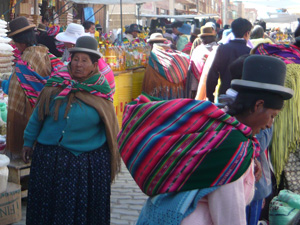The real Aguayo (native aguayo) is a hand made weave used by women from the Plateau ofPeru and Bolivia. Each woman has her own aguayo. It can be fabricated with wool of llama, alpaca or sheep; it is dyed with natural vibrant colors. These big-squared weaves are used to carry babies and small children on one’s back, to seat, put food, as well as all sorts of products. Formerly, it was men who used these aguayo weaves.
 There are 7 zones where the aguayos are fabricated: the North zone of La Paz, (including La Paz city), zones of Oruro, Cochabamba, Potosi, and finally Chuquisaca.
There are 7 zones where the aguayos are fabricated: the North zone of La Paz, (including La Paz city), zones of Oruro, Cochabamba, Potosi, and finally Chuquisaca.
Each zone has its own characteristics, passing through the surrealism of the Jalq'a weaves (known as the weaves of Potolo, in Sucre), the elegance of the Macha weaves in Potosi and the extravagance of the Tarabuco weaves.
When weaving, these pieces of aguayo, men and women write stories about their communities, symbols of their culture or things they have dreamt for this work. Of course, these stories and symbols depend of the different regions. In fact, each region has its own colors, drawings and techniques. They make their weave through abstract drawings of naive and figurative representations or include surrealist monsters.
Since there are many ways to make aguayos, depending on the region, we will mention some of them:
- The Jalq'a weave (named Potolo), is considered to be the most beautiful in Bolivia. They are characterized by the predominance of figures and the absence of geometrical shapes. Abstract and symmetric, with a dark ambient that lacks contrasts, the weavers showcase non-domestic wild animals:the Khurus. These weaves give us the vision of a continuous universe, without axis, chaotic, without light effects and difficult perception.
 -The Calcha weaves (the most representative ones) are big pieces where black predominates but with fine, almost white stripes named "pallai", where green and red colors are emphasized. The rhombus, the hooks and the strong density due to the refinement of its parts form the characteristics of this weave.
-The Calcha weaves (the most representative ones) are big pieces where black predominates but with fine, almost white stripes named "pallai", where green and red colors are emphasized. The rhombus, the hooks and the strong density due to the refinement of its parts form the characteristics of this weave.
- The Amarete weave has red and white threads that predominate, there is absence of animal or human decorations, except for the hooks that symbolize the Callahuayas (shamans) an ethnic minority of Bolivia.
The process of weaving in the machine can be done in three different ways.
- The vertical weave, where the threads extend vertically to the floor, it is the most expanded technique, but not the only one.
- The weave to the waist, where one part of the weave is brought closer to an unmovable thing (beam, tree.) and the other tied to the waist of the weaver, who controls the tension of the weave by inclining ahead.
- Finally, the horizontal weave where the threads should extend over a bar horizontally to the floor.

Today you can find multicolored aguayos in Bolivia, as opposed to the traditional ones, theseare made with synthetic material and their fabrication is semi-industrial, that is why the price is more economic.
However, because of the lack of conscience of some ethnologist who arrived from the U.S.A. and Canada, the Bolivian textile art was about to disappear forever. Today, various projects allow an equilibrium between art and commerce, through projects of Fair Trade and Sustainable Development.


